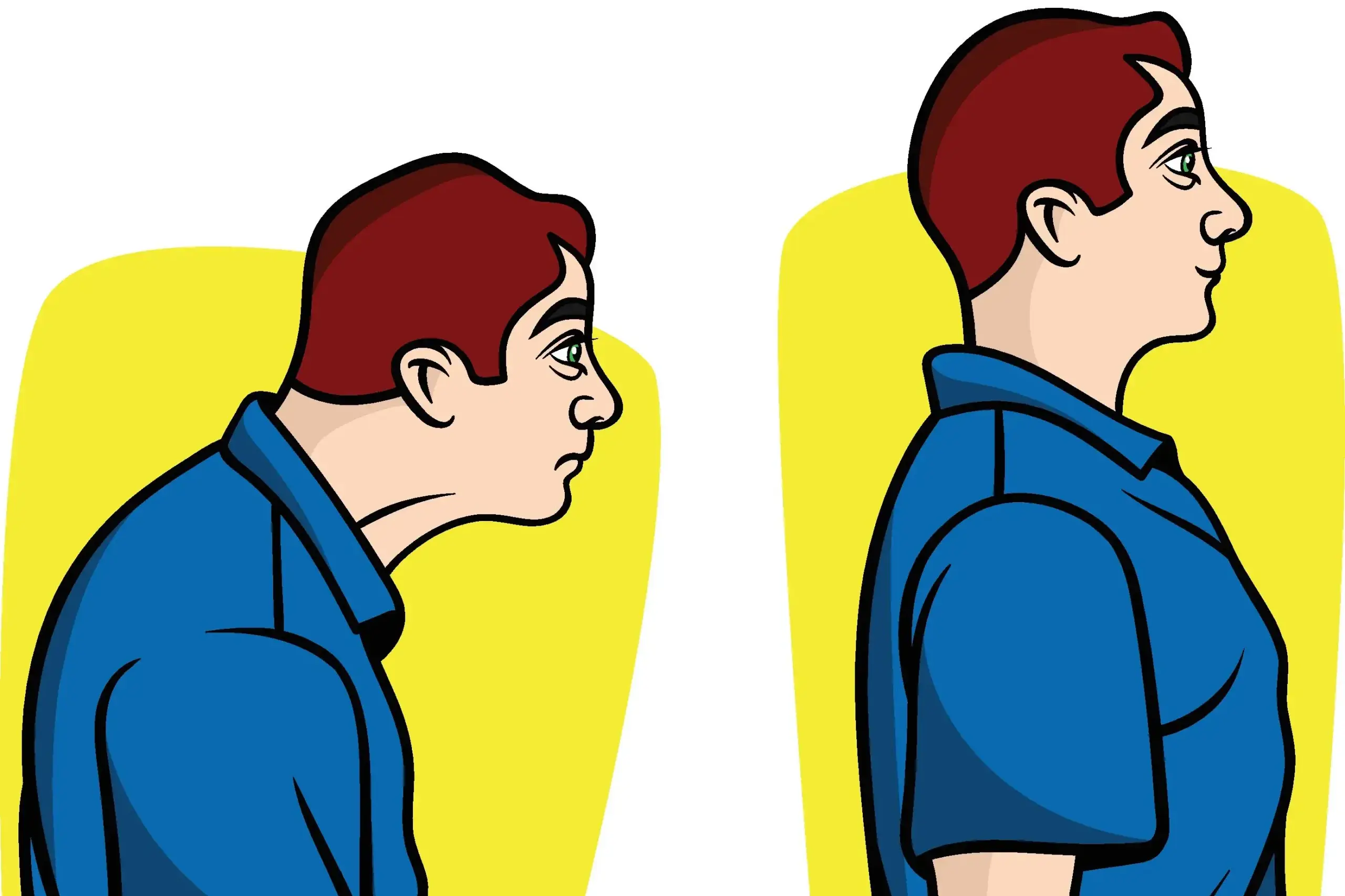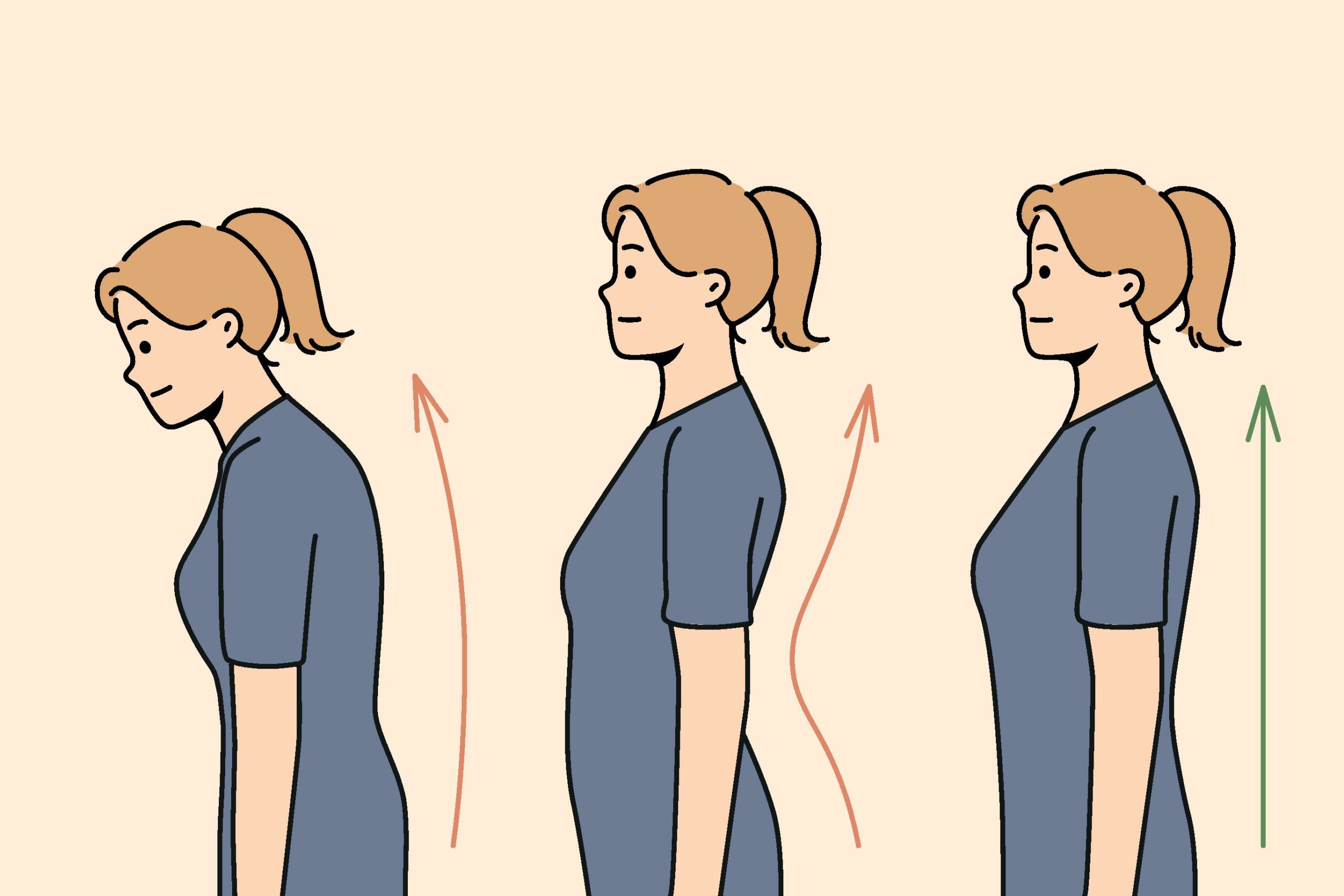Are you looking for a forward head posture “fix” to relieve constant slouching, tension in your neck and shoulders, and dealing with the dreaded foreward head posture? Well, you’ve come to the right place! In this article, we will dive into posture correction and provide five practical and effective exercises to help improve your posture.
Good posture is crucial for your appearance, overall health, attitude, and general well-being. Forward head posture, or “text neck”, is a common issue caused by prolonged sitting, hunching over electronic devices, or poor ergonomics.
These exercises are the key to a confident and upright stance. They are specifically designed to target the muscles responsible for maintaining proper posture, align your spine, and strengthen your neck, shoulders, and upper back. By practicing these exercises, you can bid farewell to the discomfort of forward head posture and stand tall with renewed energy.
We have a solution for forward head posture. Use these five practical postural correction exercises to make a positive change, stand tall, feel energized, and boost your mood. Let’s get started on the path to better posture!
Table of Contents
ToggleWhat is Forward Head Posture?
Foreward head posture, or text neck or anterior head carriage, is a postural condition characterized by the head being positioned forward and in front of the body’s center of gravity. This misalignment of the head and neck can lead to a range of physical and psychological issues. When the head is not correctly aligned with the spine, it places excessive strain on the neck and upper back muscles, leading to discomfort, pain, and even long-term health problems.
The foreward head position is often a result of our modern lifestyles, where we spend countless hours hunched over our electronic devices, sitting at desks, or engaging in activities that require prolonged periods of looking down or forward. This habitual poor posture can gradually become the norm, making maintaining a proper upright position challenging.
Recognizing and understanding the characteristics of foreward head posture is the first step in controlling this common postural issue. Individuals with forward head posture typically exhibit a rounded upper back, a protruding chin, and a noticeable gap between the back of the neck and the upper back. This misalignment can also lead to muscle imbalances, joint dysfunction, and even changes in the curvature of the spine over time. Addressing forward head posture is crucial for maintaining overall spinal health and preventing complications.
Forward Head Posture Test
The easiest way to measure foreward head posture is by using a simple ruler, and it requires a partner. Have the patient stand with their back to a wall, then measure how far the back of the head is from the wall. If the head touches the wall while naturally standing up straight, there is no forward head posture. The further the head is from the wall, the greater the degree of forward head posture.

Forward Head Posture Causes and Symptoms
The primary causes of forward head posture are often related to our modern lifestyles and habits. Prolonged sitting, excessive use of electronic devices, and poor ergonomic setups are some of the leading contributors to this postural issue.
When we spend long hours hunched over our computers, smartphones, or tablets, the muscles in the front of the neck and upper back become shortened and tight. In contrast, the muscles in the back of the neck and upper back become lengthened and weakened. This muscle imbalance pulls the head forward, creating the characteristic forward head posture.
Factors such as stress, anxiety, and poor overall muscle strength can also contribute to the development of forward head posture. Individuals who experience high levels of stress may unconsciously adopt a hunched, protective posture, further exacerbating the issue. Weak core and upper back muscles can also fail to provide the necessary support for maintaining proper spinal alignment.
It’s essential to recognize the symptoms associated with forward head posture, which can be physical and psychological. Some of the most common symptoms include:
- Neck pain and stiffness: Forward positioning of the head increases strain on the neck muscles, leading to discomfort, tension, and a limited range of motion.
- Headaches: The misalignment of the head and neck can trigger tension headaches, migraines, and even cervicogenic headaches (originating from the neck).
- Shoulder and upper back pain: The rounded upper back and forward-leaning posture can cause tightness and pain in the shoulder and upper back muscles.
- Fatigue and decreased energy levels: The constant effort required to maintain the forward head position can increase muscle tension and fatigue, leaving individuals feeling drained and less energetic.
- Breathing difficulties: Forward head posture can restrict the diaphragm’s movement, making it harder to take deep, full breaths, leading to respiratory issues.
- Decreased confidence and self-esteem: The visible physical changes associated with forward head posture, such as a hunched appearance, can negatively impact an individual’s self-perception and confidence.
Recognizing these symptoms and addressing the underlying causes of forward head posture is crucial for improving overall physical and mental well-being.
The Importance of Good Posture
Correcting forward head posture is not just about physical health. It’s about your overall well-being. When your head is positioned forward, it places significant stress on the neck, upper back, and shoulder muscles, leading to a cascade of negative consequences that can affect your daily life and mental state.
One primary reason to address forward head posture is to alleviate the physical discomfort and pain associated with this postural issue. The constant strain on the neck and upper back muscles can lead to chronic pain, stiffness, and limited range of motion, interfering with daily activities and reducing quality of life.
Moreover, forward head posture has been linked to an increased risk of developing other musculoskeletal conditions, such as herniated discs, degenerative disc disease, and even temporomandibular joint (TMJ) disorders. By correcting the misalignment of the head and neck, individuals can reduce the risk of these secondary complications and maintain a healthier spine.
Beyond the physical benefits, addressing forward head posture can also positively impact an individual’s overall well-being. Proper posture has been shown to improve mood, reduce stress and anxiety, and boost self-confidence. When we stand or sit with a confident, upright posture, we look and feel better and project a more positive and self-assured image to the world.
Furthermore, correcting forward head posture can have long-term benefits for respiratory function and overall energy levels. By improving the spine’s alignment and allowing for better diaphragmatic breathing, individuals may experience increased lung capacity, better oxygen circulation, and more consistent energy throughout the day.
In summary, the importance of correcting forward head posture cannot be overstated. By addressing this postural issue through targeted exercises and lifestyle modifications, individuals can alleviate physical discomfort, reduce the risk of secondary health problems, and enhance their overall physical and mental well-being.
Forward Head Posture Xray
Using X-rays is crucial for identifying head posture as they give a detailed view of the spine and its alignment. Visual observation and physical exams won’t provide the specific details needed to diagnose the cause of your forward head posture. X-rays show us the curvature of the cervical spine, the alignment of vertebrae, and any degeneration or abnormalities that might be there. A thorough analysis of X-rays effectively allows us to gauge the extent of your condition and create the most effective forward head posture fix for your condition.
Forward Head Posture Fix Exercises
Exercise 1: Chin tucks
The chin tuck is one of the most effective exercises for correcting forward head posture. This simple yet powerful exercise targets the muscles that maintain proper head and neck alignment.
To perform the chin tuck:
- Sit or stand with your back straight and your shoulders relaxed.
- Tuck your chin in as if trying to create a double chin. You should feel a slight stretch in the back of your neck.
- Hold the chin tuck position for 5-10 seconds, keeping your head level and not tilting it up or down.
- Repeat the chin tuck 10-15 times, taking a short break between sets.
The key to the chin tuck exercise is to focus on the head and neck movement rather than just the chin. By tucking the chin, you activate the deep neck flexor muscles, which help pull the head back into a neutral position and reduce the strain on the upper back and shoulder muscles.
It’s essential to perform the chin tuck properly to avoid straining the neck. Avoid pulling the chin too far back or tilting the head up or down. The movement should be gentle and controlled, focusing on engaging the correct muscles.
Incorporating the chin tuck into your daily routine, such as during breaks from sitting or waiting in line, can help to retrain your muscles and gradually improve your forward head posture. Consistent practice of this exercise can lead to long-term postural improvements and reduced neck and upper back discomfort.
Exercise 2: Forward Head Posture Stretches
In addition to the chin tuck exercise, incorporating neck stretches into your posture correction routine can be highly beneficial. These stretches target the muscles and connective tissues in the neck, helping to release tension and improve flexibility.
One effective neck stretch is the neck roll:
- Sit or stand with your back straight and your shoulders relaxed.
- Slowly tilt your head to the right, feeling a gentle stretch along the left side of your neck.
- Pause briefly, then slowly roll your head towards your chest.
- Continue rolling your head to the left, feeling a stretch on the right side of your neck.
- Pause briefly, then slowly roll your head back to the starting position.
- Repeat the neck roll 5-10 times, being mindful of your breathing and avoiding sudden or jerky movements.
Another helpful neck stretch is the seated or standing neck release:
- Sit or stand with your back straight and your shoulders relaxed.
- Slowly tilt your head to the right, feeling a gentle stretch along the left side of your neck.
- Hold the stretch for 30-60 seconds, keeping your shoulders relaxed and your gaze forward.
- Repeat the stretch on the left side, holding for the same duration.
- You can gently pull your head towards your shoulder to deepen the stretch.
Incorporating these neck stretches into your daily routine can help to release muscle tension, improve flexibility, and promote better head and neck alignment. Remember to listen to your body and avoid stretches that cause sharp or intense pain.
Exercise 3: Shoulder rolls
The shoulder roll is a simple yet effective exercise that can help improve posture by targeting the upper back and shoulder muscles. This exercise can be particularly beneficial for individuals with forward head posture, as it helps to open up the chest and strengthen the upper back muscles.
To perform the shoulder roll:
- Stand or sit with your back straight and your shoulders relaxed.
- Slowly roll your shoulders backward in a circular motion, feeling the movement in your upper back and shoulders.
- Inhale as you roll your shoulders back, and exhale as you roll them forward.
- Repeat the shoulder roll 10-15 times, focusing on a smooth, controlled movement.
- You can also try reversing the direction of the shoulder roll, rolling your shoulders forward and then back.
The key to the shoulder roll is to keep your movements slow and controlled, focusing on engaging the muscles in your upper back and shoulders. Avoid any jerky or rapid movements, as this can unnecessarily strain the muscles and joints.
Incorporating the shoulder roll into your daily routine, such as during breaks from sitting or while waiting in line, can help to improve your posture and reduce muscle tension in the upper back and shoulders. Over time, this exercise can help to retrain the muscles and promote better overall postural alignment.
Remember to listen to your body and adjust the intensity of the shoulder roll as needed. If you experience discomfort or pain, stop the exercise and consult a healthcare professional.
Exercise 4: Upper back stretches
Stretching the upper back muscles is another critical component of correcting forward head posture. When the head is forward, the upper back muscles can become tight and restricted, contributing to the overall postural imbalance. Incorporating upper back stretches into your routine can help release tension, improve flexibility, and promote better spinal alignment.
One effective upper back stretch is the doorway stretch:
- Stand in a doorway with your feet about shoulder-width apart.
- Extend your arms to the sides, placing your hands on the shoulder-high doorframe.
- Gently lean forward, feeling a stretch across your chest and upper back.
- Hold the stretch for 30-60 seconds, keeping your shoulders relaxed and your back straight.
- Repeat the stretch 2-3 times, adjusting the height of your hands to target different areas of the upper back.
Another helpful upper back stretch is the seated or standing thoracic extension:
- Sit or stand with your back straight and your shoulders relaxed.
- Interlace your fingers behind your back, keeping your palms facing down.
- Gently squeeze your shoulder blades together, feeling a stretch in the front of your chest and upper back.
- Hold the stretch for 30-60 seconds, breathing deeply.
- Repeat the stretch 2-3 times, adjusting the intensity as needed.
Incorporating these upper back stretches into your daily routine can help to improve flexibility, reduce muscle tension, and promote better posture. Remember to listen to your body and avoid stretches that cause sharp or intense pain.
Exercise 5: Strengthening exercises for the neck and upper back
In addition to stretching and mobility exercises, strengthening the muscles responsible for maintaining proper head and neck alignment is crucial for attaining a forward head posture fix. Building strength in the neck and upper back helps support the head and reduce neck strain.
One effective exercise for strengthening the neck muscles is the neck resistance exercise:
- Sit or stand with your back straight and your shoulders relaxed.
- Place your hand on your forehead, applying gentle pressure.
- Gently push your head against your hand, resisting the movement for 5-10 seconds.
- Repeat the exercise, pushing your head to the right, left, and back, targeting all the major neck muscle groups.
- Perform 2-3 sets of 10-15 repetitions, taking breaks as needed.
To strengthen the upper back muscles, you can try the seated (or standing) row:
- Sit or stand with your back straight, holding a resistance band in both hands.
- Pull the band towards your chest, keeping your elbows close, squeezing your shoulder blades together.
- Hold the contraction momentarily, then slowly release the band to the starting position.
- Repeat the exercise 10-15 times, focusing on proper form and engaging your upper back muscles.
- Perform 2-3 sets, taking breaks as needed.
Use these strengthening exercises to build muscle strength and endurance to support proper head and neck alignment. Start with a manageable intensity and gradually increase the difficulty as your strength improves.
Additional Tips for a Forward Head Posture Fix
In addition to the targeted exercises above, use these strategies to improve overall posture and reduce the effects of foreward head posture.
- Workplace Ergonomics: Ensure your workstation is set up to promote proper posture. This may involve adjusting the height of your computer screen, using a standing desk, or investing in an ergonomic chair with lumbar support.
- Mindfulness and Body Awareness: Regularly check in with your posture throughout the day and make conscious efforts to maintain an upright, aligned position. Set reminders or use posture-tracking apps to help you stay mindful of your body’s positioning.
- Regular Breaks and More Frequent Movement: Take frequent breaks from sitting or standing to stretch, move, and engage in light physical activity. This can help to counteract the effects of prolonged static postures.
- Stress Management: High-stress levels contribute to poor posture, as we unconsciously adopt a hunched, protective posture. Practice stress-reducing techniques like deep breathing, meditation, or yoga to help alleviate tension and improve overall well-being.
- Core Strengthening: A strong core provides a stable foundation for the spine and can support better posture. Incorporate core-strengthening exercises like planks, bridges, and abdominal crunches into your routine.
- Supportive Cervical Pillow: Along with sleeping position (stay off your stomach!), the pillow you use at night can significantly impact neck pain and forward head posture. Find the right pillow and sleeping position to prevent neck pain and forward head posture.
- Postural Awareness: Use visual or auditory cues to remind yourself to maintain proper posture. This could include placing reminders on your computer or phone or wearing a posture-correcting device.
- Gradual progress: Improving posture is a gradual process, and patience and consistency with your efforts are essential. Celebrate small wins and keep going even if progress seems slow. Consistent practice and a holistic approach can lead to long-term improvements.
The key to the forward head posture fix is to combine exercises with lifestyle changes and commit to maintaining good habits and treatment from a full body adjustment Chiropractor. Incorporating these strategies into your daily routine can improve your overall posture and well-being.
Forward Head Posture Fix Treatments in Denver
Integrative health solutions are the most effective forward head posture fix, addressing the cause of forward health posture.
Acupuncture for Forward Head Posture
Acupuncture is a very effective treatment option for forward head posture. Targeting specific points in the upper back and neck releases muscle tension, relieves pain, and improves circulation.
Chiropractic Adjustments for Forward Head Posture
Chiropractic adjustments restore motion to subluxated or “stuck” joints. The goal of the Chiropractic adjustment is to improve the movement in the spine. Poor spinal motion causes muscle spasms and joint inflammation, pulling your head out of proper alignment. Chiropractic adjustments are also excellent at relieving pain and improving range of motion. Choose our office as the Chiropractor in Denver you turn to for a forward head posture fix.
Low-level Laser Therapy for Forward Head Posture
Low-level laser Therapy (LLLT) is also known as cold laser therapy. It is a painless and non-invasive treatment that reduces inflammation, alleviates muscle tension, and promotes cellular repair (healing).
Posture “Before and After” Chiropractic Adjustment
Correcting forward head posture is crucial in maintaining a healthy, aligned spine and improving overall physical and mental well-being. These five practical exercises will help you regain proper head and neck alignment.
These exercises are powerful tools in your posture correction arsenal. Consistently practicing and committing to good posture habits will significantly improve your appearance, comfort, and overall quality of life.
A true forward head posture fix is a journey toward better postural habits and long-term spinal health. Be patient and persistent, and celebrate your progress along the way. By prioritizing your posture, you’re investing in your health. Good posture makes you feel more confident, energized, and resilient.
So, contact Integrative Health and Rehabilitation today and take the first step towards correcting your forward head posture. In addition to practicing these forward head posture fixes, be mindful of your posture throughout the day. Want to fix your forward head posture? Don’t waste time Googling “foreward head posture fix near me.” Schedule an appointment with the affordable chiropractor Denver seeks for fast, effective, and lasting pain relief, starting with a simple Chiropractic adjustment.
Clinic Director, Chiropractor
Integrative Health and Rehabilitation
Denver, CO
Dr. James Doran brings over 25 years of experience in chiropractic and integrative care. He specializes in treating the root causes of back pain, neck pain, and headaches using evidence-based methods such as chiropractic adjustments, acupuncture, dry needling, low-level laser therapy, and bioidentical hormone replacement. With a background in human nutrition and a commitment to whole-person wellness, Dr. Doran’s office is conveniently located for patients in Denver, Arvada, and Wheat Ridge achieve long-lasting relief.
P.S. Please don’t judge us for sprinkling “foreward” throughout this post. This is purely for SEO purposes.

Ready for an expert opinion? Get in touch today!
With a legacy of more than 25 years, our team specializes in helping individuals triumph over back pain, neck discomfort, and persistent headaches, all without relying on addictive medications or risky surgical procedures.






